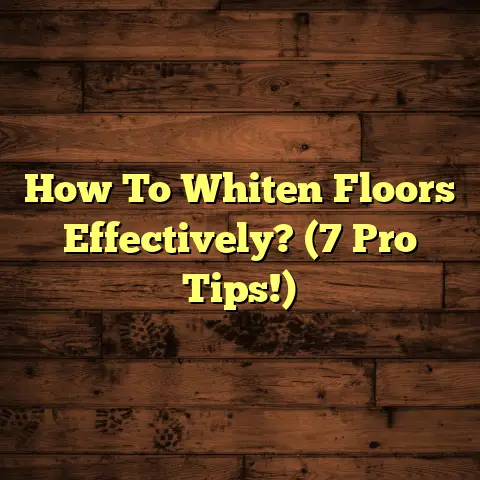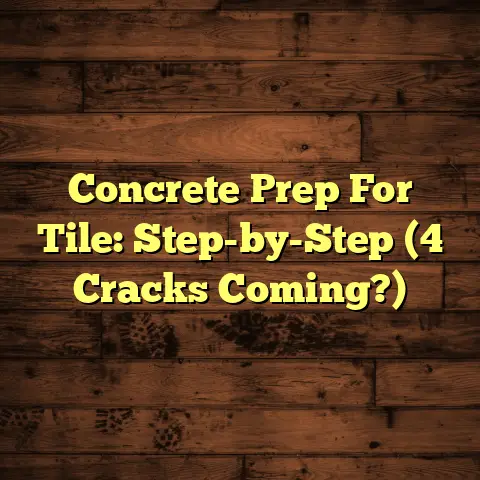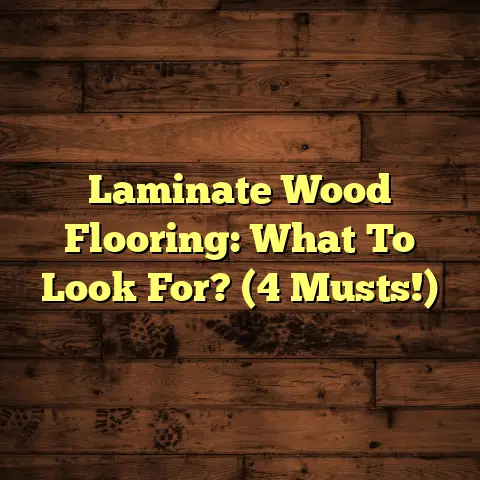Key Subfloor Material Differences? (2 To Avoid!)
Imagine this: You’re touring a home, fresh from a renovation. The paint smells new, the light fixtures gleam, and then you step onto the stunning new floor.
But wait… creak… groan…
Suddenly, you’re not admiring the surface anymore. You’re wondering, “What’s underneath? What did they use for the subfloor? Is this going to be a problem down the road?”
I’ve seen this scenario play out countless times in my years as a flooring contractor. And believe me, the subfloor is not a place to cut corners.
In this article, we’re diving deep into the world of subfloor materials. I’m going to break down the key differences, highlight materials you absolutely must avoid, and give you the knowledge to make smart choices for your flooring project.
1. Understanding Subfloors: The Foundation
of Your Flooring System
So, what exactly is a subfloor?
Think of it as the unsung hero beneath your beautiful floors. It’s the structural layer directly on top of your floor joists, providing a stable, level surface for your finished flooring.
Without a proper subfloor, you’re looking at problems like:
- Sagging or uneven floors: No one wants that roller coaster effect.
- Moisture issues: Leading to mold, mildew, and rot. Yuck!
- Noise transmission: Hello, noisy neighbors (or kids!).
- Flooring failure: Premature wear and tear, cracked tiles, and more.
Basically, the subfloor is the backbone of your entire flooring system. It provides structural support, helps control moisture, and even contributes to sound insulation.
There are several types of subflooring used today, each with its own pros and cons:
- Plywood: A classic choice, known for its strength and stability.
- Oriented Strand Board (OSB): A more economical option, but with some limitations.
- Concrete: Common in basements and slab-on-grade construction.
- Cement Board: Used primarily as an underlayment for tile and stone.
2. Key Subfloor Material Differences
Let’s get into the nitty-gritty. Here’s a comparison of common subfloor materials based on key factors:
| Material | Durability | Cost | Ease of Installation |
|---|---|---|---|
| Plywood | High | Medium | Moderate |
| OSB | Medium | Low | Moderate |
| Concrete | High | Medium | Difficult |
| Cement Board | High | Medium | Moderate |
Plywood:
- Pros: Strong, stable, resists warping better than OSB.
- Cons: Can be more expensive than OSB.
OSB:
- Pros: Cost-effective, readily available.
- Cons: More susceptible to moisture damage than plywood, can swell and delaminate.
Concrete:
- Pros: Extremely durable, resistant to moisture and pests.
- Cons: Can be cold and hard underfoot, requires proper preparation for flooring installation.
Cement Board:
- Pros: Excellent for wet areas (bathrooms, kitchens), provides a stable base for tile.
- Cons: Can be brittle, requires careful handling during installation.
The best choice for your project depends on several factors, including your budget, the type of flooring you’re installing, and the conditions in your home.
3. The Two Subfloor Materials to Avoid
Okay, now for the part you’ve been waiting for. Let’s talk about the subfloor materials I actively steer clients away from. These materials can lead to serious problems down the road, costing you time, money, and a whole lot of frustration.
Material 1: Particle Board
Particle board, also known as chipboard, is an engineered wood product made from wood chips, sawdust, and resin, pressed together under high pressure and heat.
It’s often used in furniture, shelving, and, unfortunately, sometimes as a subfloor material.
Why is it sometimes chosen?
Cost, plain and simple. Particle board is one of the cheapest options out there. Builders or homeowners looking to save a few bucks might be tempted to use it as a subfloor.
The Drawbacks (and why you should avoid it like the plague):
- Susceptibility to Moisture: This is the big one. Particle board is like a sponge. It absorbs moisture like crazy, causing it to swell, warp, and lose its structural integrity.
- Low Structural Integrity: Compared to plywood or OSB, particle board is weak. It can crumble under pressure, especially when wet.
- Difficult to Repair: Once particle board is damaged, it’s very difficult to repair. Often, the only solution is to replace the entire section.
Real-Life Example:
I once worked on a home where the previous owner had used particle board as a subfloor in the bathroom. A small leak under the toilet went undetected for months. By the time the homeowner noticed the problem, the particle board had completely disintegrated. We had to rip out the entire bathroom floor, replace the subfloor with plywood, and then reinstall the tile. It was a costly and time-consuming nightmare.
Material 2: Old or Damaged Plywood
Plywood, as we discussed, is generally a good subfloor material. But old or damaged plywood is a different story.
Over time, plywood can be compromised by:
- Moisture Damage: Just like particle board, plywood can be damaged by water. This can lead to delamination (where the layers of wood separate) and rot.
- Pest Infestation: Termites, carpenter ants, and other pests can wreak havoc on plywood, weakening its structure.
- Structural Degradation: Even without moisture or pests, plywood can simply degrade over time, losing its strength and stability.
The Risks of Using Old or Damaged Plywood:
- Compromised Flooring Stability: A weak subfloor can lead to squeaky floors, uneven surfaces, and premature wear and tear on your finished flooring.
- Mold and Mildew Growth: Damaged plywood can create a breeding ground for mold and mildew, which can pose serious health risks.
- Costly Repairs: Ignoring a damaged subfloor can lead to even bigger problems down the road, requiring extensive and expensive repairs.
Expert Opinion:
I always tell my clients, “Your subfloor is like the foundation of your house. If it’s not solid, everything else is going to suffer.” Using old or damaged plywood is like building a house on sand. It’s just not worth the risk.
4. Factors to Consider When Choosing Subfloor
Materials
Choosing the right subfloor material isn’t just about avoiding the bad stuff. It’s also about selecting the best material for your specific situation. Here are some key factors to consider:
- Moisture Levels: Is your home in a humid climate? Are you installing flooring in a bathroom or kitchen? If moisture is a concern, choose a material that is resistant to water damage, like plywood or cement board.
- Climate: Extreme temperature fluctuations can affect the stability of some subfloor materials. Consider the climate in your area when making your selection.
-
Type of Flooring: Different flooring types have different subfloor requirements.
- Tile: Requires a very stable, rigid subfloor to prevent cracking. Cement board is often the best choice.
- Hardwood: Needs a smooth, level subfloor that is free of moisture. Plywood is a good option.
- Carpet: Can be more forgiving, but still requires a solid subfloor. OSB or plywood can work well.
- Local Building Codes: Building codes often specify minimum requirements for subfloor materials. Be sure to check your local codes before making your selection.
5. Conclusion
The subfloor is the foundation of your entire flooring system. Choosing the right material is crucial for ensuring the longevity, performance, and overall comfort of your floors.
Avoid particle board and old or damaged plywood at all costs. These materials can lead to serious problems down the road, costing you time, money, and a whole lot of headaches.
Take the time to research your options, consider the factors I’ve outlined, and make an informed decision. Your floors (and your wallet) will thank you for it. Remember, a beautiful home starts from the ground up – literally!





